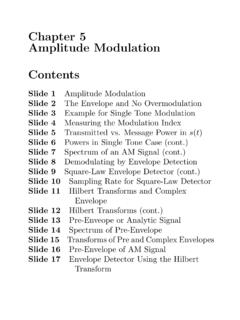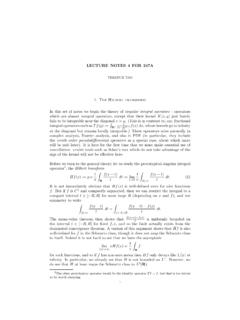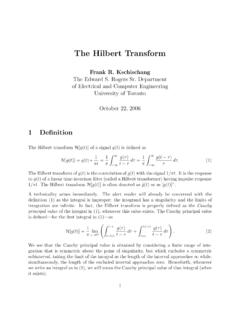Search results with tag "The hilbert transform"
Chapter 5 Amplitude Modulation Contents - UMD
user.eng.umd.eduHilbert transforms are used extensively for analysis and signal processing in passband communication systems. Let x(t) have the Fourier transform X(ω). The Hilbert transform of x(t) will be denoted by ˆx(t) and its Fourier transform by Xˆ(ω). The Hilbert transform is defined by the integral xˆ(t) = x(t)∗ 1 πt = 1 π Z ∞ −∞ x(τ ...
Single Sideband Modulation (SSB) - Ryerson University
www.ee.ryerson.caH(f): wideband phase shifter (Hilber Transform). Thus, if we delay the phase of every component of m(t) by π/2 (without changing its amplitude), the resulting signal is m h(t), the Hilbert transform of m(t). Therefore, a Hilbert transformer is an ideal phase shifter that shifts the phase of every spectral component by −π/2. 35
LECTURE NOTES 4 FOR 247A The Hilbert transform - UCLA
www.math.ucla.eduLECTURE NOTES 4 FOR 247A TERENCE TAO 1. The Hilbert transform In this set of notes we begin the theory of singular integral operators - operators
The Hilbert Transform
web.eecs.utk.eduThe Hilbert transform of g(t) is the convolution of g(t) with the signal 1/πt. It is the response to g(t) of a linear time-invariant filter (called a Hilbert transformer) having impulse response 1/πt. The Hilbert transform H[g(t)] is often denoted as ˆg(t) or as [g(t)] ...
The Hilbert Transform - University of Toronto
www.comm.utoronto.caHilbert transform essentially acts to exchange the real and imaginary parts of G(f) (while changing the sign of one of them). Energy Spectral Density: Suppose that g(t) is an energy signal. Then, since jG^(f)j= jG(f)j, both G^(f) and G(f) have exactly the same energy spectral density. Thus, for exam-




